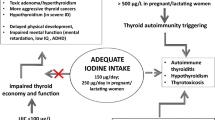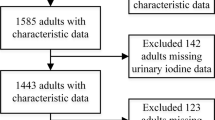Abstract
The sera of all patients with completely suppressed TSH response to TRH obtained during one year (n = 668), and of those with diminished TSH response (n = 153) were screened for total serum iodine content. The ratio between serum iodine and thyroxine iodine below 1.5 indicates none or only a minor degree of iodine contamination, whereas a ratio above 1.5 is a clear index of exogenous iodine contamination. Eighty-four (21.3%) of 395 patients with overt hyperthyroidism were iodine contaminated. No prevalence of hyperthyroidism with hyperthyroxinemia could be detected as compared to T3-hyperthyroidism in the contaminated groups. Surprisingly, the iodine contamination rate was twice as high in 273 patients with suppressed TSH response to TRH but normal thyroid hormone levels and not fully explained thyroidal diseases. A high incidence of multifocal autonomous adenomas of the thyroid is the most probable explanation for the TSH suppression in iodine contaminated patients with normal thyroid hormone levels.
Similar content being viewed by others
References
Bürgi H., Wimpfheimer C., Burger A., Zaunbauer W., Rösier H. Changes of circulating thyroxine, triiodothyronine and reverse triidothyronine after radiographic, contrast agents. J. Clin. Endocrinol. Metab. 43; 1203, 1976.
Mahlstedt J., Fischer H., Joseph K., Meinhold H., Glöbel B. Beeinflussung der T4/T3 Konversion durch jodhaltige Cholegraphika. Nuc. Compact. 8: 164, 1977.
Schicha H., Facorro U., Schürnbrand P., Shreivogel J., Emrich D. Frequency of iodine contamination in a thyroid clinic. J. Mol. Med. 4: 177, 1980.
Stäubli M., Studer H. Behandlung der Arrhythmien mit Amiodarone. Schweiz. Med. Wochenschr. 111: 460, 1981.
Ermans A.M., Camus M. Modifications of thyroid function induced by chronic administration of iodide in the presence of “autonomous” thyroid tissue. Acta Endocrinol. (Kbh.) 70: 463, 1972.
Habermann J., Leisner B., Pickardt C.R., Witte A., Scriba P.C. Influence of acute iodine incorporation on thyroid function and thyroidal iodine content. Acta Endocrinol. (Kbh.) (Suppl.) 240: 20, 1981.
Jonckheer M.H., Deconinck F., Swaenepoel L Upon the importance of differentiation between two forms of hyperthyroidism by means of x-ray-fluorescence scanning. In: Stockigt J.R., Nagataki S. (Eds.), Thyroid Research VIII. Australian Academy of Science, Canberra, 1980, p. 637.
Leisner B., Kantlehner R., Igl W., Henze H.G., Lissner J. Die quantitative Fluoreszenzszintigraphie in der Schild-drüsendiagnostik. Der Nuklearmediziner 3: 249, 1980.
Livadas D.P., Koutras D.A., Souvatzoglou A., Beckers C. The toxic effects of small iodine supplements in patients with autonomous thyroid nodules. Clin. Endocrinol. (Oxf.) 7: 121, 1977.
Horn K., Scriba P.C. Kliniscn-chemische Schilddrusenfunktionsdiagnostik. I. Bestimmung des proteingebundenen Jods im Serum (PB127I). Dtsch. Ges. Klin. Chemie — Mitteil. Nr. 5: 3, 1970.
Erhardt F., Marschner I., Pickardt C.R., Scriba P.C. Verbesserung und Qualitätskontrolle der radioimmunologischen Thyreotropin-Bestimmung. Z. Klin. Chem. Klin. Biochem. 11: 381, 1973.
Gärtner R. Kewenig M. Horn K. Scriba P.C. A new principle of thyroxine (T4) and triiodothyronine (T3) radioimmunoassay in unextracted serum using antisera with binding optima at extreme pH ranges. J. Clin. Chem. Clin. Biochem. 78: 571, 1980.
Horn K. Kubiczek Th. Pickardt C.R., Scriba P.C. Thyroxin-bindendes Globulin (TBG): Präpration, radioimmunologische Bestimmung und klinisch-diagnostische Bedeutung. Klin. Wochenschr. 55: 881, 1977.
Horn K., Koeppen D. Pickardt C.R., Scriba P.C. Normalisierung des T3/T4 Quotienten im Serum bei Struma-Patienten unter Kaliumjodid. Ein Beispiel der Autoregulation der Schilddrüse. Klin. Wochenschr. 53: 94, 1975.
Horn K. Trijodthyronin (T3). Zur Bestimmung und pathophysiologischen Bedeutung. Urban & Schwarzenberg, Munchen, 1976.
Habermann J., Heinze H.G. Horn K. Kantlehner R., Marschner I. Neumann J., Scriba P.C. Alimentarer Jodmangel in der Bundesrepublik Deutschland. Dtsch. Med. Wochenschr. 100: 1937, 1975.
Horster F.A., Klusmann G., Wildmeister W. Der Kropf: eine endemische Krankheit in der Bundesrepublik? Dtsch. Med. Wochenschr. 100: 8, 1975.
Frey K.W., Engelstädter M. Kropfhäufigkeit und Tracheal-Einengung im poliklinischen Krankengut Münchens. Münch. Med. Wochenschr. 118: 1555, 1976.
Miller J.M., Horn R.C., Block M.A. Autonomous functioning thyroid nodule in the evolution of nodular goiter. J. Clin. Endocrinol. Metab. 27: 1264, 1967.
Studer H., Hunziker H., Ruchti C. Morphologic and functional substrate of thyrotoxicosis caused by nodular goiters. Am. J. Med. 65: 227, 1978.
Adams D.D., Kennedy T.H., Stewart J.C., Utiger R.D., Vidor G.I. Hyperthyroidism in Tasmania following iodide supplementation: Measurements of thyroid stimulating autoantibodies and thyrotropin. J. Clin. Endocrinol. Metab. 41: 221, 1975.
Mahlstedt J., Joseph K. Dekompensation autonomer adenome der schilddruse nach prolongierter jodzufuhr. Dtsch. Med. Wochenschr. 98: 1748, 1973.
Stewart J.C., Vidor G.I., Buttfield I.H., Hetzel B.S. Epidemic thyrotoxicosis in Northern Tasmania: Studies of clinical features and iodine nutrition. Aust. N.Z., J. Med. 3: 203, 1971.
Vidor G.J., Stewart J.C., Wall J.R., Wangel A., Hetzel B.S. Pathogenesis of iodine-induced thyrotoxicosis: Studies in Northern Tasmania. J. Clin. Endocrinol. Metab. 37: 901, 1973.
Author information
Authors and Affiliations
Additional information
This work was supported by the Bundesministerium d. Inneren (AZ. St. Sch. 790c)
Rights and permissions
About this article
Cite this article
Habermann, J., Leisner, B., Witte, A. et al. Iodine contamination as a cause of hyperthyroidism or lack of TSH response to TRH stimulation (Results based on a screening investigation). J Endocrinol Invest 5, 153–156 (1982). https://doi.org/10.1007/BF03349470
Received:
Accepted:
Published:
Issue Date:
DOI: https://doi.org/10.1007/BF03349470




